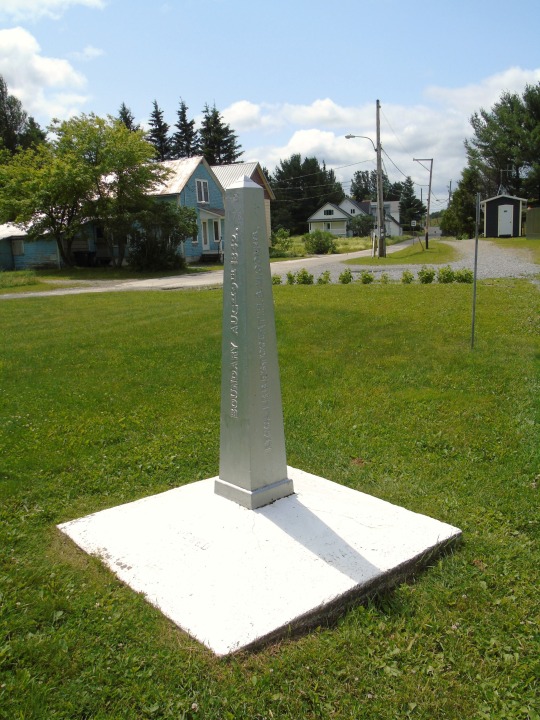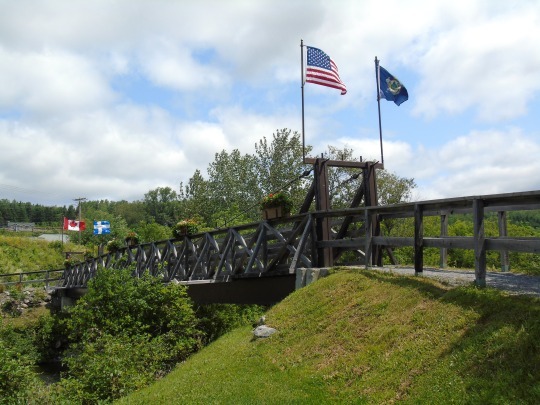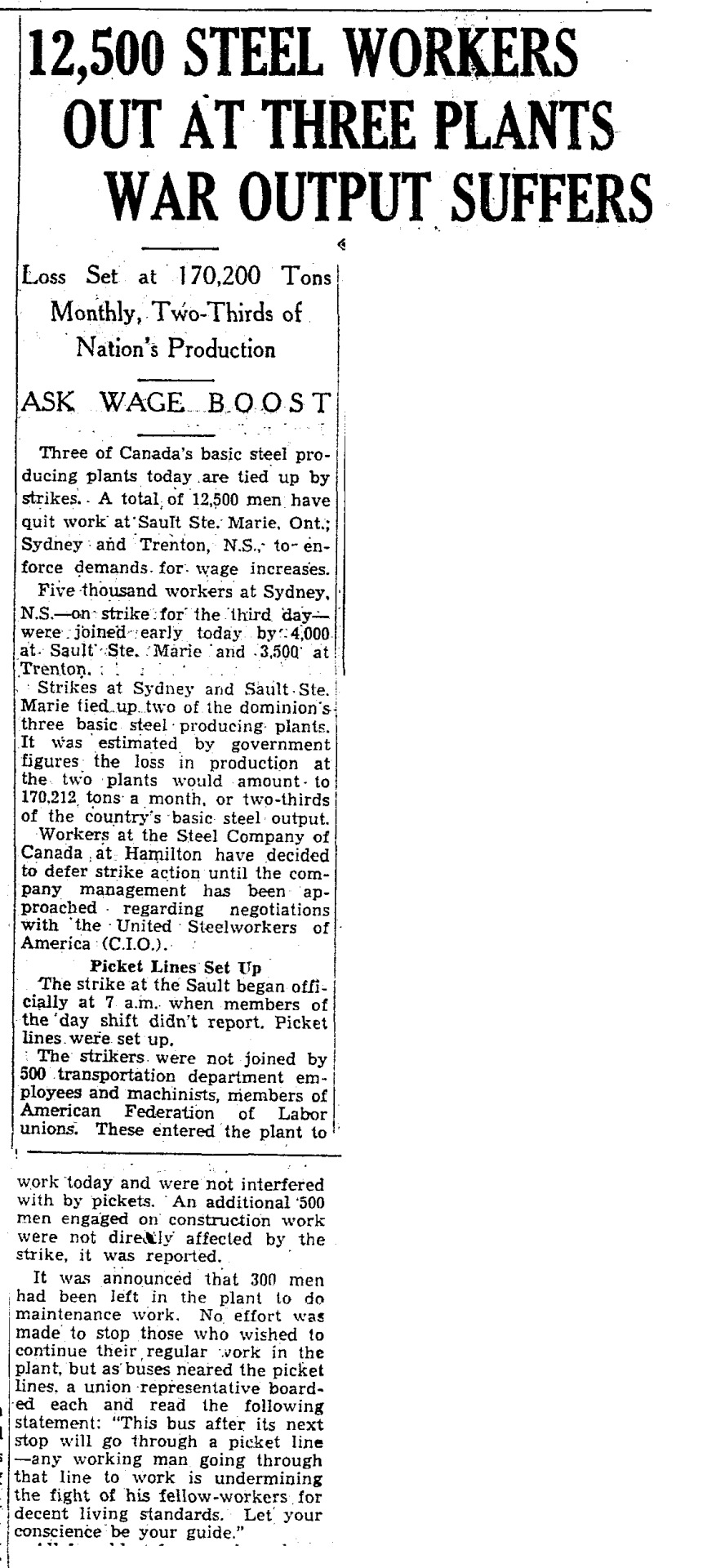#sault ste. marie
Explore tagged Tumblr posts
Text
Agawa Canyon Train, Canada: A train of almost 8 hours journey that taking through the Agawa canyon showing natural beauties of Northern Canada. Forest,hills lake, trees with vivid color of fall... The Agawa Canyon is a shallow canyon located deep in the sparsely populated Algoma District in Northeastern Ontario, Canada. The Agawa Canyon Wilderness Park is only accessible by hiking trail or the Agawa Canyon station on the Algoma Central Railway, and is located 114 miles by rail north west of Sault Ste. Marie. Wikipedia
#Agawa Canyon Train Tour#Algoma District#Sault Ste. Marie#Northeastern Ontario#Ontario#Canada#north america#north america continent
426 notes
·
View notes
Text

View of snow-covered Japanese torii or gate in Sault Ste. Marie, Michigan. Printed on front: "Torri [sic] from Japan, presented by Governor Osborn, Soo, Mich." Printed on back: "Published exclusively for A.E. Young, Sault Ste. Marie, Mich. C.T. American Art Colored. CT Co., Chicago." Handwritten on back: "We went over to Canada last night. There are lots of French people up here, and on Sunday they preach in French at some of the Masses. Regards to all, Claire." Card is postmarked September 3, 1929.
Burton Historical Collection, Detroit Public Library
#torii gate#sault ste. marie#michigan#1929#postcards#vintage postcards#osborn#sault#soo#curteich#a.e. young#detroit public library
42 notes
·
View notes
Text



October 1979.
Canadian comedy team on trial for obscenity.
#maclean and maclean#can't joke about anything anymore#history of canadian comedy#comedy records#sault ste. marie
9 notes
·
View notes
Text
SAULT STE. MARIE REPORTBACK! Maybe a dozen bigoted chuds vs. 100+ antifascists defending their Drag Queen (and King!) Story Time - WHO YA GOT!!!
137 notes
·
View notes
Text
"The first public reference to Klan activity in Canada appeared in the Montreal Daily Star, which announced the organization of a branch of ‘the famous Ku Klux Klan’ in Montreal in 1921, and reported that ‘a band of masked, hooded and silent men’ had gathered in the northwest part of the city behind the Mountain. In 1921, the Klan set up an office in West Vancouver, and British Columbia newspapers began to publish solicitations for Klan membership. KKK crosses were sighted burning across New Brunswick: in Fredericton, Saint John, Marysville, York, Carleton, Sunbury, Kings, Woodstock, and Albert. James S. Lord, the sitting member of the New Brunswick legislature for Charlotte County, becamea highly publicized convert. Later the Klan would infiltrate Nova Scotia, burning ‘fiery crosses’ on the lawn of the Mount Saint Vincent Convent, and in front of St John the Baptist Roman Catholic Church at Melville Cove near Halifax’s North-West Arm.
Reports of Klan activities surfaced in Ontario as well, where white American organizer W.L. Higgitt began a tour in Toronto in 1923. In the summer of 1924, a huge Klan gathering took place in a large wooded area near Dorchester. Cross-burning, designed to intimidate the village’s few Black residents, was carried out with great pomp and ceremony. In Hamilton in 1924, police arrested a white American named Almond Charles Monteith in the act of administering initiation rites to two would-be Klanswomen. Monteith was later charged with carrying a loaded revolver. Along with the revolver, police confiscated a list of thirty-two new members (‘some of them prominent citizens’), correspondence regarding thirty-six white robes and hoods, and a $200 invoice for expenses for ‘two fiery crosses.’ Monteith denied any involvement in recent cross-burnings on Hamilton Mountain, and was convicted on the weapons charge. The day after Monteith’s conviction, the arresting officer received a letter bearing a terse message: ‘Beware. Your days are numbered. KKK.’ Monteith’s conviction did nothing to put a crimp in the Klan’s membership drive. Between four hundred and five hundred members paraded through Hamilton in a KKK demonstration in the fall of 1929.
By June 1925 there were estimates of eight thousand Klan members in Toronto; headquarters were installed in Toronto’s Excelsior Life Building. The summer of 1925 witnessed hundreds of crosses burned across Chatham, Dresden, Wallaceburg, Woodstock, St Thomas, Ingersoll, London, and Dorchester. A group of hooded Klansmen tried to proceed en masse through the chapel of a London church to show their appreciation of the anti-Catholic address that had been delivered to the congregation. At a rally of more than two hundred people at Federal Square in London, J.H. Hawkins, claiming to be the Klan’s ‘Imperial Klailiff,’ proclaimed:
‘We are a white man’s organization and we do not admit Jews and colored people to our ranks. [ … ] God did not intend to create any new race by the mingling of white and colored blood, and so we do not accept the colored races.’
More than one thousand showed up at a similar rally in Woodstock.
At what was billed as the ‘first open-air ceremony of the Klan’ in Canada, two hundred new members were initiated at the Dorchester Fairgrounds in October 1925, in front of more than one thousand avid participants. The ‘first Canadian Ku Klux burial’ took place in London the next year, as robed and hooded Klansmen, swords at their sides and fiery crosses at hand, showed up to perform a ritual at the graveside of one of the Drumbo Klan. Ontario chapters sprang up in Niagara Falls, Barrie, Sault Ste Marie, Belleville, Kingston, and Ottawa. New headquarters appeared in a Vancouver mansion in 1925, and local chapters called ‘Klaverns’ sprang into existence in New Westminster, Victoria, Nanaimo, Ladysmith, and Duncan. Klan bonfires lit up Kitsilano Point. By 1928, the Vancouver Klan was soliciting signatures for a petition to demand that Asian Canadians be banned from employment on government steamships. A ‘Great Konklave’ was held in June 1927 in Moose Jaw, Saskatchewan, where an estimated ten thousand people stood by as hooded Klansmen burned a sixty-foot cross and lectured to them on the risks of racial intermarriage. Demanding an immediate ban on marriage between white women and ‘Negroes, Chinese or Japanese,’ the Klan proclaimed: ‘one flag, one language, one race, one religion, race purity and moral rectitude.’ The Saskatchewan group would later disaffiliate from Eastern Canada, to create an entirely separate western wing that was credited with signing up 25,000 members. In Alberta, ‘Klaverns’ came into existence in Hanna, Stettler, Camrose, Forestburg, Jarrow, Erskine, Milo, Vulcan, Wetaskiwin, Red Deer, Ponoka, Irma, and Rosebud. Alberta membership peaked between 5,000 and 7,000, but the Klan newspaper, The Liberator, produced out of Edmonton, purported to maintain a circulation of 250,000. Nor were the activities of the Klan restricted to rallies and cross-burnings. In 1922, the Klan was linked to a rash of torchings that wreaked more than $100,000 damage upon three Roman Catholic institutions: the Quebec Cathedral, the rest-house of the Sulpician order at Oka, Quebec, and the junior seminary of the Fathers of the Blessed Sacrament in Terrebonne. In 1922, threatening letters signed by the Klan were delivered to St Boniface College in Winnipeg. Before the year was out, the college burned to the ground, causing the death of ten students. In 1923, similar letters, signed by the Klan, were sent to local police and Roman Catholic authorities in Calgary. In Thorold, Ontario, the KKK intervened in a local murder investigation in 1922, issuing a warning to the town mayor to arrest an Italian man suspected of the crime by a specified date or face the fury of the Klan. The letter continued: ’The clansmen of the Fiery Cross will take the initiative in the Thorold Italian section. Eighteen hundred armed men of the Scarlet Division are now secretly scouring this district and await the word to exterminate these rats.’ In 1922, the Mother Superior of a Roman Catholic orphanage in Fort William received a letter signed ‘K.K.K.’ threatening to ‘burn the orphanage.’ The mayor of Ottawa was mailed a vitriolic letter, demanding he pay more attention ‘to Protestant taxpayers’ or the Klan would take ‘concerted action.’ Two Klansmen stole and destroyed religious paraphernalia from the tabernacle of the St James Roman Catholic church near Sarnia. The Ancaster Klan attempted to intimidate the African Brotherhood of America from erecting a home for ‘colored children and aged colored folk.’
The Belleville Klan visited the office of the Belleville Intelligencer, demanding that the manager dismiss a Catholic printer employed by the paper. The Sault Ste Marie Klan launched a concerted campaign to force the big steel mills to fire their Italian workers. A rifle bullet was fired at George Devlin during a wedding reception in Sault Ste Marie, with a blazing cross left behind to claim responsibility for the act. In 1924, local Klansmen surrounded the Dorchester home of a white man believed to be married to a Black woman. Threats were made to burn a cross outside the house of a white Bryanstown resident reputed to be involved with a Black woman. In 1927, several crosses were burned on the lawn of a white family believed to be running a brothel in Sault Ste Marie. The family was forced to flee their home.
Klan activities were also responsible for the removal of a francophone Roman Catholic postmaster in Lafleche, Alberta. The Alberta Klan promoted boycotts of Catholic businesses. The Drumheller KKK, which boasted a membership embracing forty of the town’s most prominent businessmen and mine owners, burned a cross on the lawn of a local newspaper columnist after he wrote a satirical comment about the Klan. Alberta Klansmen used bullets and flaming crosses to try to intimidate members of the Mine Workers Union of Canada during their bitter labour dispute in the Crow’s Nest Pass. Lacombe Klansmen wrote to the editor of the Alberta Western Globe after he opposed the Klan, threatening ‘severe punishment including the burning of his house and business to the ground.’ The same group kidnapped, and tarred and feathered a local blacksmith.
Throughout these activities, white police and fire marshals stood by, often present at the incendiary meetings and cross-burnings, content to reassure themselves there was ‘no danger.’ Despite the widespread evidence of lawlessness, Klan authorities tended to claim official disengagement whenever there was property damage or personal injury. Eschewing responsibility, they insisted that their organization had nothing to do with such events. Remarkably, the authorities largely respected these assertions of innocence, concluding that, without definitive proof that would tie named Klan officials to specific threatening letters or violent deeds, nothing further could be ascertained. Apart from the arrest and conviction of Almond Charles Monteith for possessing an unauthorized revolver, the only Klan event that attracted legal attention was the dynamiting of St Mary’s Roman Catholic Church in Barrie, Ontario, in 1926. On the evening of 10 June 1926, a stick of dynamite shattered the stained-glass windows and blasted a four-foot hole through the brick wall of Barrie’s St Mary’s Roman Catholic Church. Buffeted about by the explosion, Ku Klux Klan flyers were scattered throughout the street, strewn among the brick, glass, and wooden debris. Barrie was a major stronghold of Ku Klux Klan activity, and organizers had drawn a crowd of two thousand to watch hooded Klansmen conduct a ritual cross-burning on a hill outside of Barrie several weeks earlier. At that ceremony, thirty-year-old William Skelly, a shoemaker who had emigrated one year earlier from Ireland, swore fealty to the tenets of the Klan, to uphold Protestant Christianity and white supremacy. He was initiated as a member in good standing. It was Skelly whom the police arrested for the bombing days later.
Skelly voluntarily admitted his Klan membership to the police, and confessed that, the night before the bombing, Klan members met to discuss ‘a job to be pulled off.’ There was a drawing of lots, and when Skelly drew the ‘Fiery Cross,’ he realized he was the designated man. Skelly claimed that he was intimidated by fellow Klansmen, who ‘made [him] drunk with dandelion wine and alcohol,’ and forced him to carry out the deed under threat of bodily harm. In fact, he told the police, he had joined the Klan in the first place only because he ‘had had considerable difficulty in securing steady work,’ and was told that, if he joined, the Klan ‘would look after him,’ finding him employment. Skelly also implicated two other Barrie Klan officials, Klan ‘Kleagle’ William Butler and Klan Secretary Clare Lee. Criminal charges of causing a dangerous explosion, attempting to destroy property with explosives, and possession of explosives were laid against all three white Klansmen.
This time the Ontario attorney general’s office issued an official statement that ‘no group can take into its own hands the administration of the law.’ The white deputy attorney general, Edward J. Bayly, became involved personally when he made arrangements for a leading white Toronto barrister, Peter White, KC, to prosecute the trio on behalf of the Crown. Skelly, Butler, and Lee were all found guilty at a jury trial in October, and sentenced to five, four, and three years, respectively. Officials from the Toronto headquarters of the Ku Klux Klan denied all responsibility, claiming throughout that Skelly ‘acted on his own initiative,’ despite all the evidence to the contrary." - Constance Backhouse, Colour-Coded: A Legal History of Racism in Canada, 1900-1950. Toronto: University of Toronto Press, 1999. pg. 183-193.
#canadian history#racism in canada#ku klux klan#racism#reign of terror#anglo canadians#antisemitism in canada#settler colonialism in canada#academic quote#reading 2024#crime and punishment in canada#history of crime and punishment in canada#thorold#belleville#sault ste. marie#vancouver#toronto#hamilton#drumheller#calgary#kingston ontario#montreal#barrie
10 notes
·
View notes
Text
MISSING JANUARY 15 2024
ALERT: EAST ALGOMA OPP SEEK ASSISTANCE IN LOCATING MISSING 5-YEAR-OLD GIRL: Today, January 15th, shortly after 10:30 a.m., the East Algoma OPP received a report of a missing person from Mississauga First Nation.
Police were advised that five-year-old Nakina Boyer and her mother Jeanette departed their residence on this date. There was a scheduled appointment they failed to attend.
Nakina is described as indigenous, 4'0" tall, 80 pounds, heavy build, brown eyes, and straight light brown hair. The family is known to frequent Batchewana First and has ties to the City of Sault Ste Marie. Mother is described as indigenous, 5'3" tall, approximately 145 pounds, medium build, brown eyes, and long brown hair.
Anyone with information regarding the whereabouts of Nakina is urged to contact the OPP at 1-888-310-1122 or their nearest police authority.
Should you with to remain anonymous, you may contact Crime Stoppers at 1-800-222-8477 (TIPS) or submit the information online at www.saultcrimestoppers.com where you may be eligible to receive a cash reward of up to $2,000.
Photos provided by East Algoma OPP


4 notes
·
View notes
Text









The Oregon Treaty (June 15, 1846) established the 49th parallel as the border between the United States and Canada, from the Rocky Mountains to the Strait of Juan de Fuca.
#Niagara Falls#Prescott#Sault Ste. Marie#Lake Pohénégamook#International Bridge#Maine#Québec#Canada#USA#travel#vacation#summer 2015#2017#original photography#US-Canada border#Parc de la Frontière#Estcourt Station#landscape#countryside#flying west#on board#Oregon Treaty#15 June 1846#US history#Canadian history#49th parallel#that's not the 49th parallel here of course#tourist attraction#landmark
1 note
·
View note
Video
Postcrossing US-10895263 by Gail Anderson Via Flickr: Postcard with a photo of the International Bridge and Soo Locks in Sault Ste. Marie, Michigan in the United States. Sent by a Postcrossing member in Michigan.
0 notes
Text




0 notes
Text
Smalltown Dreamer: An Interview with Eric Brombacher
I was listening to Only the Host’s Indie Music Hunt the other day when I heard an upbeat rocker called “Picture” by Eric and the Soo. Turns out the song has been around since 2020, and the band has been around for even longer. From their press materials: Debut album Small Town Dreamer sees Toronto-based songwriter Eric Brombacher looking backwards to his past and his childhood in his hometown of…

View On WordPress
1 note
·
View note
Text






northern ontario gothic iii // ontario, canada // 2007-2014 // ©
#photographers on tumblr#urban photography#photography#my photos#american gothic#canada#ontario#northern ontario#moody aesthetic#film#rural#canadian gothic#timmins#marathon#thunder bay#sault ste marie#sudbury
62 notes
·
View notes
Text

View of men and women in three canoes paddling through rapids in Sault Ste. Marie, Michigan. Printed on front: "9485. Shooting the rapids, Sault Ste. Marie, Mich. Copyright 1906 by Detroit Publishing Co." Printed on back: "Phostint card. Made only by Detroit Publishing Co." Handwritten on back: "I wish you were here with me. We are now on Lake Superior and it is frightfully rough. We are just having a dandy time. I will try to write a long letter from Port Arthur. Lovingly, Marjorie." Card is postmarked July 27, 1907.
Courtesy of the Burton Historical Collection, Detroit Public Library
#canoes#sault ste. marie#michigan#rapids#shooting the rapids#boat#boats#canoe#canoeing#boating#detroit publishing co#1906#1907#postcard#postcards#vintage#vintage postcards#rough#frightfully rough#soo#michigan history#phostint#dandy time#detroit public library
69 notes
·
View notes
Photo
This train through boreal forest in autumn is almost too beautiful. Like a perfect fragrance or Broadway show. Save your gasps. I've only been on twice now hoping for autumnal trip. The tickets sell out pretty quickly in prime forest time.




The assistance of the Algoma Central on their expeditions was an immense gift for Harris and his friends, as the only way into the forests of the Shield before the development of the bushplane was by rail. You can sense his excitement in a letter written to J.E.H. MacDonald, anticipating “that we may proceed to biff the landscape out of a cocked hat at our sweet will.” The forest is a lush green in June, but the most famous paintings made by the Group were made in the autumn, and not surprisingly that’s when bookings on the Agawa Canyon train are hardest to get.
More here.
#lake superior#Travel Photography#landscape photography#sault ste. marie#canada#algoma#group of seven#scenic train
7 notes
·
View notes
Note
WAIT IS IT YOOPERS BIRTHDAY TODAY (December 17th)
IM SORRY I FORGOT. FORGIVE ME.
Im sorry We barely have any snow this year. I hate it too :(
“OLD. I AM OLD. LOOK,” Yooper pointed to her hair, “IT’S WHITE!”
“It’s always been white. Since you were born,” Marquette blinked, “Mine’s white. I’m not old.”
Yooper patted Marquette on the arm ‘reassuringly’, “That’s a good mindset to have in these years of your life. Keeps you optimistic.”
Sault Ste. Marie squinted at her granddaughter, “What am I the—?”
“DEAD.”
12 notes
·
View notes
Text

"12,500 STEEL WORKERS OUT AT THREE PLANTS; WAR OUTPUT SUFFERS," Toronto Star. January 14, 1943. Page 1. ---- Loss Set at 170,200 Tons Monthly, Two-Thirds of Nation's Production ---- ASK WAGE BOOST ---- Three of Canada's basic steel producing plants today are tied up by strikes. A total of 12,500 men have quit work at Sault Ste. Marie, Ont.; Sydney and Trenton, N.S., to enforce demands for wage increases.
Five thousand workers at Sydney, N.S. - on strike for the third day - were joined early today by 4,000 at Sault Ste. Marie and 3,500 at Trenton.
Strikes at Sydney and Sault Ste. Marie tied up two of the dominion's three basic steel producing plants. It was estimated by government figures the loss in production at the two plants would amount to; 170,212 tons a month, or two-thirds of the country's basic steel output.
Workers at the Steel Company of Canada at Hamilton have decided to defer strike action until the company management has been approached regarding negotiations with the United Steelworkers of America (C.I.O.).
Picket Lines Set Up The strike at the Sault began officially at 7 a.m. when members of the day shift didn't report. Picket lines were set up.
The strikers were not joined by 500 transportation department employees and machinists, members of American Federation of Labor unions. These entered the plant to work today and were not interfered with by pickets. An additional 500 men engaged on construction work were not direly affected by the strike, it was reported.
It was announced that 300 men had been left in the plant to do maintenance work. No effort was made to stop those who wished to continue their regular work in the plant, but as buses neared the picket lines, a union representative boarded each and read the following statement: "This bus after its next stop will go through a picket line - any working man going through that line to work is undermining the fight of his fellow-workers for decent living standards. Let your conscience be your guide."
#sault ste. marie#sydney nova scotia#trenton#strike#picket line#picketing#steel workers#steel plant#steel industry#algoma steel#dominion steel#united steel workers of america#central industrial organization#hamilton#wage demands#wage increase#wage freeze#price controls#canada during world war 2#working class struggle
9 notes
·
View notes
Text

The International Bridge. Photo possibly taken just north of the intersection of W Portage Ave and W Easterday Ave
[Check out our vintage photography store on Redbubble]
#ID 0315#August#1966#Michigan#USA#green#blue#grey#exterior#urban#architecture#nature#art#history#60s#jwytpzw#Summer#Sault ste Marie
5 notes
·
View notes
